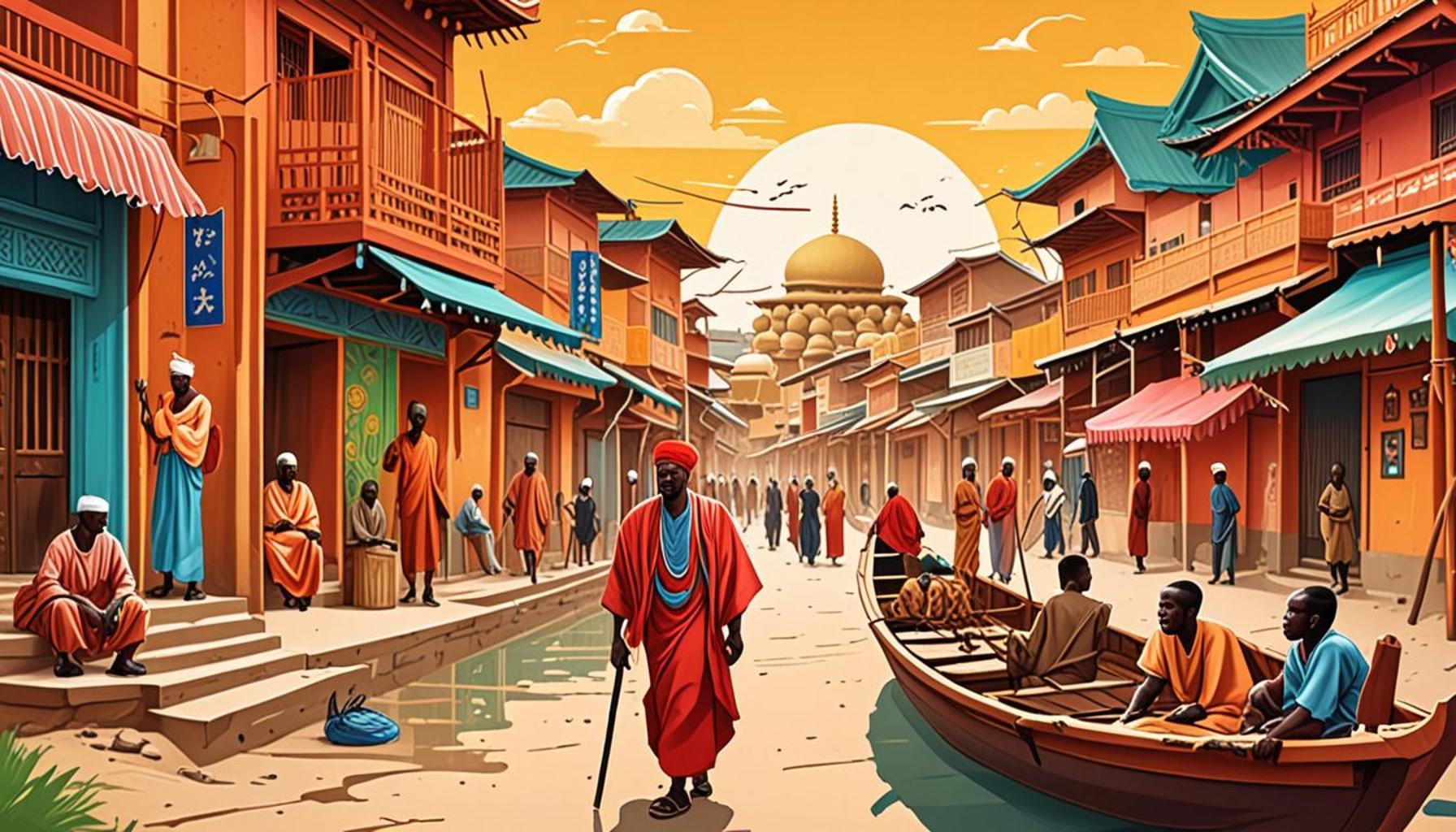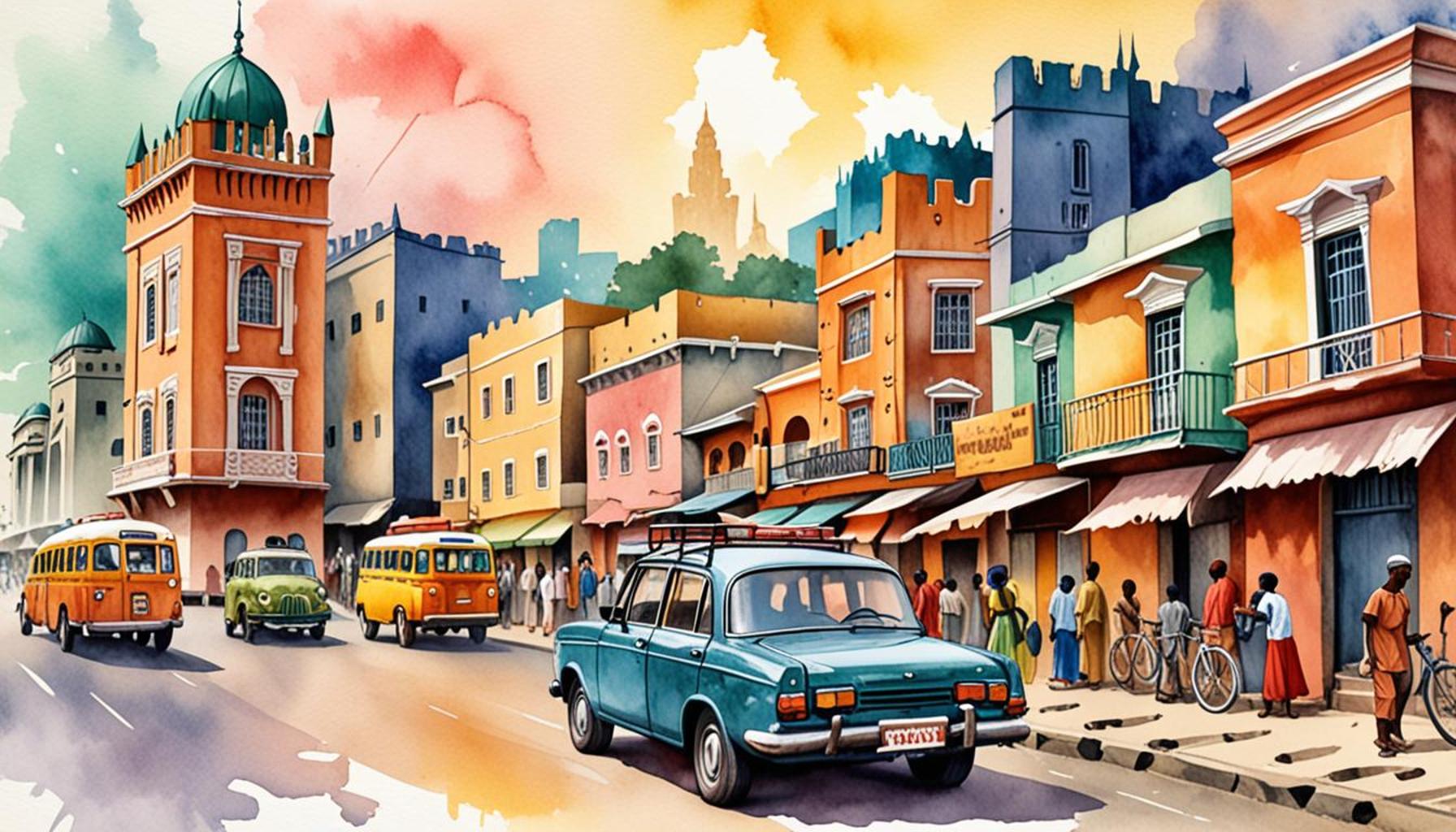Discovering the History of Kano: Tourist Itineraries through Cultural Heritage

Unveiling Kano’s Rich Tapestry
Kano, one of Nigeria’s oldest cities, serves as a vibrant tapestry of history and culture. With a heritage that spans centuries, this northern gem holds stories of trade, tradition, and transformation. Visitors are welcomed into a world where the past intertwines with the present, shaping a unique cultural experience.
Key Highlights of Kano’s Cultural Heritage
- Aso Rock Trade Routes: Once a bustling center for trade, Kano was pivotal in connecting the ancient west-African trade networks. Merchants from various parts of Africa would converge here, trading everything from gold and spices to textiles and leather goods. This not only made Kano wealthy but also a cultural melting pot where diverse traditions met and mingled.
- The Great Mosque: This architectural marvel stands as a testament to Kano’s Islamic heritage and draws in worshippers and tourists alike. Originally built in the 15th century but reconstructed in the 19th century, the mosque features stunning Sudanese architectural styles, intricate calligraphy, and expansive courtyards that echo the city’s deep religious significance.
- Old City Walls: The remnants of these walls speak volumes about the city’s strategic importance in history. Built in the 14th century, they once protected the city from invaders and encircle the Old City of Kano. Today, parts of these ancient walls still stand, reminding visitors of the fierce resistance and resilience of its people.
- Kano Dye Pits: Experience the traditional art of indigo dyeing, a craft that has been preserved for generations. The Kano Dye Pits are a colorful spectacle where artisans skillfully dye textiles using age-old techniques. Visitors are often invited to see the process firsthand and even try their hand at creating their unique patterns.
Exploring Kano is not just about visiting landmarks; it’s about immersing oneself in a living narrative. From the vibrant, bustling markets of Kurmi to the serene cultural sites like the Gidan Makama Museum, one can literally walk through the pages of history. Each alley and courtyard invites tourists to dive deep into the city’s profound roots, revealing stories of resilience, trade, and cultural fusion.
Why Visit Kano?
Intriguingly, Kano’s cultural heritage offers:
- Unique experiences that illuminate Nigerian history. Each corner of the city offers glimpses into the lives of its inhabitants, showcasing traditions that have been passed down through generations.
- Opportunities to engage with local artisans and their crafts. From leatherwork to traditional jewelry making, visitors can support these artisans while gaining a deeper appreciation of their skills.
- A chance to witness the fusion of ancient traditions with modern influences. As you navigate the city, the contrast of traditional mud-brick architecture alongside modern buildings highlights the dynamic evolution of Kano.
As you prepare to discover this captivating city, anticipation builds to unveil the rich narratives that Kano has to offer. Your journey through its cultural heritage promises to be both enlightening and memorable, leaving you with a greater understanding of Nigeria’s rich history and vibrant future.
YOU MAY ALSO LIKE: Read read another article
Exploring the Influences Behind Kano’s Cultural Landscape
Kano’s cultural heritage is not merely a collection of sites; it is a vibrant expression of the city’s history, shaped by the ebb and flow of its diverse inhabitants and their traditions. As travelers make their way through the city, they encounter a rich mosaic of influences that have come together over centuries, enriching Kano’s unique identity. This journey through time offers invaluable insights, making it essential to explore the principal cultural highlights meticulously crafted into a visitor’s itinerary.
The Cultural Significance of the Kurmi Market
One cannot visit Kano without experiencing the pulsating heart of the city, the Kurmi Market. This bustling marketplace is not just a commercial hub but also a social gathering point that showcases the city’s historical importance as a trade center. Established in the 15th century, Kurmi Market continues to thrive, offering an array of goods ranging from traditional spices and textiles to handcrafted artifacts. Here, visitors can enjoy:
- A Tantalizing Array of Local Cuisine: Savor the famous ‘suya’ skewered meat and other local delicacies that reveal the flavors and culinary traditions unique to Kano.
- Interactions with Local Traders: Engaging with local vendors adds a personal touch to the shopping experience, allowing visitors to learn about the history of their crafts and the stories behind their products.
- Vibrant Cultural Expressions: Witness traditional music and art forms, as local artisans often showcase their work, embodying the creative spirit of the people.
Kano’s Architectural Wonders
The architectural landscape of Kano tells a story of its own, encapsulating the city’s *historical significance and religious faith*. Notably, the Great Mosque of Kano stands as a beacon of Islamic architecture, mesmerizing visitors with its expansive beauty and intricate designs. A visit to this magnificent structure should be part of every itinerary because it not only serves as a place of worship but also as a cultural landmark that embodies the spirituality and devotion of the community.
As you walk through the city, don’t miss the chance to observe the Gidan Makama Museum, which offers visitors a window into the history of Kano through its extensive collections of artifacts and textiles. Housed in an ancient palace, this museum encapsulates the city’s journey from an ancient Emirate to a modern urban center. Its exhibits illuminate the evolution of local governance, trade, and society, inviting visitors to delve deeper into Kano’s past.
Connecting with Tradition
For those seeking immersive experiences, a visit to the Kano Dye Pits is an absolute must. This age-old tradition of indigo dyeing exemplifies Kano’s artisanal heritage. Visitors can witness skilled craftsmen at work and might even participate in the dyeing process, crafting unique textile patterns to take home as souvenirs. Such experiences highlight the relevance of traditional crafts within the modern marketplace, making them invaluable components of the local economy.
In summary, a journey through Kano invites visitors to absorb its history, appreciate its cultural richness, and engage with the local community. As travelers navigate through the city’s myriad attractions, they partake in a living history that is both enlightening and culturally enriching, setting the stage for an unforgettable exploration of Nigeria’s historical gems.
Exploring the Cultural Gems of Kano
Kano, one of the oldest cities in West Africa, is a treasure trove of cultural heritage that has fascinated tourists for centuries. The city’s rich history is reflected in its architectural marvels, vibrant markets, and traditional festivals. As you journey through Kano, several key itineraries promise a glimpse into its extraordinary past.
| Cultural Heritage Site | Significance |
|---|---|
| Gidan Makama Museum | Home to artifacts that depict Kano’s royal history and trade. |
| Kano City Wall | A UNESCO World Heritage site showcasing ancient defensive architecture. |
Travelers often indulge in the colorful atmosphere of the Kano Central Market, where bargaining is an art and local crafts are on full display. As you navigate through the bustling stalls filled with textiles, spices, and handmade goods, you can truly appreciate the cultural vibrancy of Kano.
In addition to its physical sites, Kano also celebrates its cultural heritage through numerous festivals, which provide visitors with an engaging perspective on local traditions. The Kano Durbar Festival, which showcases stunning horse parades and traditional dressing, serves as a perfect example of how historical traditions continue to thrive in modern Kano.
Whether you’re a history enthusiast or a curious traveler, exploring these cultural itineraries in Kano offers a profound connection to the past and a gateway into its evolving identity.
CHECK OUT: Click here to explore more
Diving Deeper into Kano’s Historical Treasures
To truly appreciate Kano’s cultural tapestry, visitors must delve into the lesser-known yet equally fascinating aspects of its heritage. From ancient trading routes to cultural festivals, Kano offers various experiences that encapsulate the city’s rich history and vibrant community life.
The Legacy of the Trans-Saharan Trade Routes
Kano’s strategic location made it a pivotal point on the *Trans-Saharan trade routes*, facilitating the exchange of goods and ideas. Visitors can explore the remnants of this glorious past by visiting the Kano City Walls, which served as a robust defense for the city during its heyday. These ancient walls, stretching over 14 kilometers, not only protected the city but also symbolized its prosperity as a trade hub. Walking along these historic walls, one can envision the bustling market days of yore, filled with merchants from the North and South trading gold, ivory, and textiles.
Continue to the historic Kano Emirate Palace, where centuries of royal history converge. This magnificent structure is an exemplary representation of Hausa architecture. Here, tourists can engage in guided tours that provide insights into the traditions, governance, and the significance of the Emirate in the region’s history. The Emirate, a symbol of heritage, still plays a role in preserving cultural practices and hosting important festivals.
Experiencing Festivals: A Window into Local Culture
Kano comes alive during its annual festivals, showcasing the city’s vibrant cultural practices. The most notable among these is the Kano Durbar Festival, a spectacular celebration held annually to mark the end of Ramadan and the Eid al-Adha festivities. This event features a grand parade of horsemen adorned in traditional attire, reminiscent of the city’s illustrious history as a traditional Emirate. Visitors are often enthralled by the rhythmic drumming, the galloping of horses, and the colorful displays that celebrate both the past and present.
During the Durbar, attendees can engage with the local community, offering a firsthand experience of Kano’s social fabric and its rich customs. Dance performances and theatrical displays are not to be missed, providing a deeper understanding of the stories that shape the lives of the people.
Kano’s Culinary Heritage: A Flavor Journey
Beyond the sights, the flavors of Kano encapsulate its cultural diversity. An essential part of any itinerary should include a *cooking class or food tour* that highlights Kano’s culinary traditions. Participants can learn to prepare local specialties such as jollof rice, masa (rice cakes), and aromatic stews, each imbued with the region’s unique spices. These experiences do not just fill the stomach; they offer a taste of history, as each dish tells a story of the diverse influences that have shaped Kano’s culinary landscape.
This culinary adventure often leads to discussions with local chefs who share the significance of each ingredient and the historical context behind the dishes. Thus, savoring the flavors of Kano becomes a delightful journey through time.
As a final touchpoint, visitors should make a trip to a local cultural center or art gallery, which often displays contemporary art inspired by traditional themes. These centers work tirelessly to preserve the artistic spirit of Kano while also promoting modern interpretations, allowing visitors to witness a blend of history and modernity.
In exploring these facets of Kano’s heritage, one not only witnesses the richness of its past but also engages with the spirit of its people, making for an unforgettable cultural experience.
YOU MAY ALSO LIKE: Read read another article
Conclusion: A Journey through Time and Tradition
In conclusion, Kano stands as a testament to Nigeria’s rich history and diverse cultural heritage, offering travelers an unparalleled glimpse into a world shaped by centuries of tradition and trade. As we have explored, the city boasts a wealth of historical sites, from the imposing Kano City Walls to the regal beauty of the Kano Emirate Palace, each revealing stories of resilience and prosperity. The allure of the city extends beyond its monuments, with the vibrant Kano Durbar Festival serving as a lively celebration that encapsulates the region’s spirit and communal ties.
Moreover, the culinary experiences available in Kano provide an engaging way for visitors to immerse themselves in local culture. Learning to prepare traditional dishes like jollof rice and masa not only fuels the body but also nourishes the soul with stories of heritage and tradition. Likewise, the local cultural centers offer platforms for contemporary artists to weave historical narratives into modern expressions, showcasing Kano’s dynamic spirit.
For those ready to embark on a journey through time, Kano is a rich canvas waiting to be explored. Each corner of the city presents an opportunity to connect with its past and witness the vibrancy of its culture today. As tourism grows, it is essential to celebrate and preserve these invaluable heritages, ensuring that the stories of Kano continue to resonate with future generations. By following an itinerary that embraces both the historical and cultural dimensions of this remarkable city, travelers can forge meaningful connections that last well beyond their visit. Discover Kano, and become a part of its ongoing narrative!


